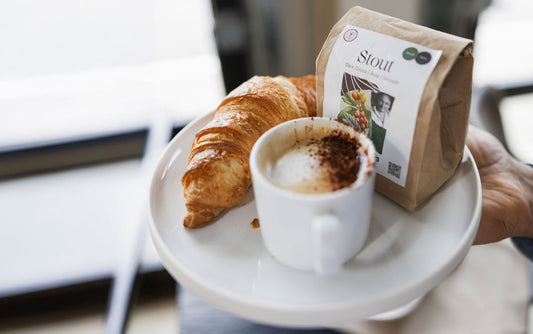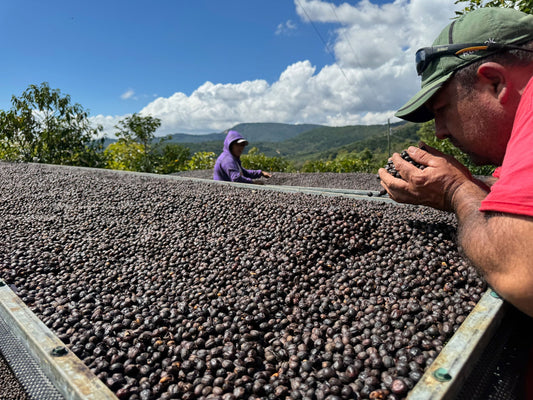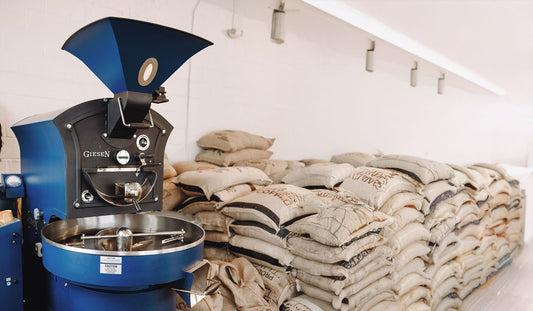Knowing the differences between light, medium, and dark roast coffees can help you choose the coffees that suit your taste preferences. But not just that, knowing different coffee roasting methods can increase your appreciation for the skill, knowledge, and creativity behind your coffee too!
The origin and terroir of each coffee bean, such as soil type, climate, altitude, and water source, play a role in shaping its unique flavor profile. The methods employed in harvesting and processing impact the unique tastes, scents, and texture of coffee due to human factors. Roasting highlights these attributes, showcasing the complete capabilities of each coffee.
Each coffee roast type requires precise attention to heat, duration, and airflow in order to attain the perfect balance. Roasters function as both scientists and artists, modifying variables to extract the finest flavors. Roasting is a crucial phase in the journey from farm to cup, where skill and care make a significant impact.
1. Light Roasts

Light roasts bring out the most delicate and vibrant flavors, focusing on the intrinsic qualities of the bean rather than flavors introduced by the roast itself. Typically roasted between 350–400°F, the roast is halted shortly after the “first crack”—an audible pop that signals the release of moisture and gasses from inside the beans. These coffees remain light brown, with no visible oil or sheen on the surface, as the roasting process hasn’t progressed far enough to break down the cellular structure and release oils.
Flavor
Among the different coffee roasts, light roasts highlight the bean’s origin most transparently. The flavors tend to be bright, crisp, and often fruit-forward with hints of citrus, stone fruits, or florals, depending on the bean variety and processing method. However, microclimate conditions, such as slight differences in rainfall or sun exposure, can dramatically shift the tasting notes, making light roasts a favorite for those seeking complexity.
Because the roast doesn’t progress far enough to trigger significant Maillard reactions or caramelization, the natural acidity from chlorogenic acids stays intact. This acidity gives light roasts their characteristic zing, but also creates a light body—a mouthfeel that feels more tea-like than syrupy.
Light roasts are especially common in washed coffees from regions like Ethiopia, Kenya, and Colombia, where the focus is on clarity and clean acidity. These beans demand precision in both roasting and brewing, as their delicate flavor compounds can easily be overshadowed or lost.
Caffeine Amount
Many people believe that light coffee roast types contain less caffeine than dark roasts, but this is a misconception with a more intricate reality. When evaluated based on weight, light roasts have a higher amount of caffeine because their beans are denser and smaller, holding onto more moisture during the roasting process. On the other hand, if you are using volume measurements for coffee, a scoop of dark roast will result in more beans due to their lower density and greater volume they occupy.
Weighing coffee instead of measuring by volume is preferred by baristas and coffee enthusiasts for better dosing and consistent flavor extraction, especially with pour-over or espresso brewing methods.
Roasting Style
Precise temperature control is essential for all of the different coffee roasts, but it’s especially important for light roasts. Light roasting demands absolute control over heat and airflow, as it provides minimal room for error. Roasters need to carefully monitor the first crack to determine the roast’s progress, because stopping the roast too early can result in beans that are grassy or underdeveloped, while roasting even slightly too long risks dulling the necessary acidity and clarity.
Because the caramelization process remains limited, roasters must ensure that the beans’ internal moisture and gasses (primarily CO₂) are properly released during roasting. If not managed well, the result could be inconsistent extraction during brewing, leading to sour, flat, or imbalanced flavors.
Charge temperature (the initial roasting temperature) and roaster drum speed are critical factors when roasting light. Too much heat can scorch the beans before their flavors develop, while too little heat can stall the roast, trapping unpleasant vegetal notes. Light roasting requires both technical skill and experience, making it a hallmark of specialty coffee roasters who prioritize transparency and origin expression over roast-imposed flavors.
2. Medium Roasts

Medium roasts are often considered the sweet spot between light and dark, offering the best of both worlds. Roasted at 400–430°F, these beans are typically pulled between the first and second crack. It's a delicate window that requires precise timing, giving the beans a chestnut brown color at the end.
Flavor
Medium roasts retain elements of origin flavors but with added depth and sweetness from the roasting process. While maintaining some bright acidity (particularly in washed coffees), they add new flavors of caramel, nuts, or milk chocolate. This can be attributed to the Maillard reaction – a complex chemical process where sugars and amino acids interact under heat, producing new compounds that contribute to browning and sweetness. It operates on the same principle as searing a steak or caramelizing onions, where heat alters natural sugars into richer, more profound flavors.
Compared to light roasts, medium roasts offer a heavier body and a smoother, rounder mouthfeel, with reduced acidity. This makes them a popular choice for those who prefer not as sharp as a light roast, but not as bold as a dark one. For this reason, medium roasts are ideal for brews like drip coffee, French press, and batch brew where both origin clarity and body are desirable.
Roasting Style
While light roasts leave little room for error, different medium coffee roasts provide slightly more flexibility. The challenge lies in finding the perfect development time—too short, and the roast will taste underdeveloped, lacking sweetness; too long, and the bean edges into dark territory, losing the delicate acidity.
The control a roaster has over temp, airflow, and drum speed is vital for achieving well-balanced medium roasts. As the beans are subjected to higher temperatures compared to lighter roasting methods, there is a potential risk of scorching or tipping (where the edges of the beans get burned) if heat is applied too forcefully. Additionally, roasters must be attentive to airflow settings—insufficient airflow can cause the beans to stall, while excessive airflow may cool the beans too rapidly, resulting in dull, uninspiring flavors.
One of the trickiest aspects of roasting medium coffee is managing development time. It is the period after the first crack, where the flavors fully develop. Pulling the beans too early may still taste like a light roast, lacking the characteristic sweetness of a medium roast. Leave them in too long, and they start to resemble a dark roast, losing origin clarity in favor of roast-driven notes.
This balancing act is what makes medium roasts a true test of a roaster’s skill. The goal is to create a coffee that expresses both the bean’s natural flavors and the sweetness introduced by the roast. Amongst different coffee roasts, this is a dance between origin and craft. Many specialty coffee roasters consider medium roasts to be their most versatile offering, capable of highlighting complex beans from regions like Colombia, Brazil, and Guatemala, where sweetness and acidity coexist harmoniously.
Compared to light types of coffee roasts, medium roasts offer a heavier body and a smoother, rounder mouthfeel, with reduced acidity. This makes them a popular choice for those who prefer not as sharp as a light roast, but not as bold as a dark one.
3. Dark Roasts

Dark roast beans are taken to 430–450°F, typically roasted until the end of the second crack. This is a point where internal pressures force the cell walls to break, releasing oils to the surface. The beans are dark brown to nearly black, with sometimes a glossy sheen from these oils. At this level, the focus shifts from preserving origin characteristics to creating roast-dominant flavors, making dark roasts a favorite for those who prefer intense, full-bodied coffee.
Flavor
The goal of a dark roast is to produce deep, complex flavors with minimal acidity, resulting in a heavier body. Expect notes of dark chocolate, toasted nuts, caramel, and spices, sometimes with subtle hints of smoke or even char. Because the terroir-driven nuances fade at higher temperatures, the focus shifts to flavors created through caramelization and carbonization.
While some lower-quality dark roasts can taste burnt or flat, well-executed dark roasts still retain hints of the bean’s origin beneath the boldness. For instance, an expertly roasted Brazilian bean may still carry nutty undertones, or a Sumatran coffee might offer a touch of earthy spiciness despite the darker profile. The challenge for roasters is to find the sweet spot that delivers powerful flavors without crossing into unpleasant bitterness or charred tastes.
Caffeine Amount
Many of us think that dark roast coffee has a higher caffeine content, but it is technically inaccurate. Though higher roasting temperatures can burn some caffeine off, the variation between different coffee roast levels is minimal. In fact, when compared by weight, dark roasts might actually have slightly lower caffeine due to moisture loss and cellular breakdown. Nevertheless, the bold flavor often causes individuals to perceive dark roasts as more caffeinated, even though the caffeine levels are generally similar.
To ensure consistent dosing and flavor accuracy, it's essential to weigh coffee instead of measuring by volume. Since dark beans are lighter and occupy more space, using a scoop could result in under-dosing.
Roasting Style
Roasting dark coffee requires careful attention and involves considerable risk. When temperatures surpass 430°F, the bean's cell walls start to decompose, causing the release of oils and raising the chances of over-roasting. If the process is pushed too far, the coffee may develop bitter, ashy tastes that overwhelm the overall flavor profile.
At such temperatures, it is crucial to control the airflow. With not enough airflow, the smoke can get trapped in the drum, resulting in a smoky tasting coffee. However, an excessive amount of airflow may cause the beans to cool too rapidly, causing the roasting process to be disrupted and leading to underdeveloped flavors despite the beans looking dark.
Cooling is also vital. The beans need to be rapidly cooled to stop residual heat from further cooking them post-removal from the drum. Numerous roasters utilize high-speed cooling trays to cease the roasting process and preserve the intended flavor profile.
Find Your New Favorite Coffee

The best way to fully grasp the complexities of different coffee roasts is to try them yourself. Every type of coffee roast provides a unique taste which can range from the tangy brightness of a light roast to the fulfilling nutty notes of a medium roast.
At Ebru Coffee, we do more than just roast; we work closely with our farmers to make sure every step from farm to cup shows the dedication and passion put into our specialty coffee beans.
Not sure where to begin? We are here to help! If you are new to trying out different coffee roasts or searching for your next favorite, feel free to get in touch without any hesitation. We are thrilled to offer our expertise in finding the perfect roast that matches your tastes.





